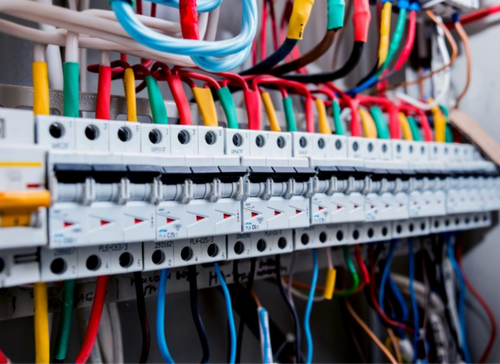Advanced BRE Automation Australia: Transforming Your Automation Demands
Advanced BRE Automation Australia: Transforming Your Automation Demands
Blog Article
The Ultimate Overview to Electrical Setup: Tips and Strategies for a Safe and Efficient Home Electrical Wiring System
In the world of home maintenance, couple of elements are as vital yet often neglected as the electric circuitry system. By checking out the subtleties of electric safety measures and energy-saving methods, this comprehensive overview will certainly shed light on the details of home electrical wiring, equipping people to take charge of their home's electrical framework.
Understanding Electric Precaution
To make certain the safety and security of both individuals and home, understanding and executing correct electric safety and security measures is critical in any type of home circuitry task. It is vital to conduct an extensive examination of the electric system prior to starting any wiring project to determine potential threats or concerns that require to be addressed.
Furthermore, utilizing the ideal tools and equipment is important for maintaining security during electric installations. Protected gloves, voltage testers, and protective eyeglasses are some of the fundamental safety and security gear that ought to be used to stop electric shocks or crashes. It is likewise essential to de-energize circuits before working with them and to label all circuits and breakers plainly to avoid confusion.
Vital Devices for Home Circuitry
Making certain the correct execution of electric safety measures in home wiring tasks includes making use of a specific collection of necessary devices designed to facilitate the installment procedure successfully and securely. Some of the key devices needed for home electrical wiring projects include a voltage tester for examining online cables, cable pole dancers for removing insulation from cables, a cable cutter for specifically reducing cables to size, a screwdriver set for securing electrical components, electrical tape for insulation and securing connections, a wire ripper for stripping wire sheathing, and a multimeter for gauging voltage, existing, and resistance.
Step-by-Step Electrical Installation Guide
Starting an electrical installation project requires meticulous planning and adherence to security standards. Before starting any type of job, guarantee you have a comprehensive strategy detailing the layout of the electrical system, consisting of the placement of electrical outlets, switches, and components. Consider the power demands of each device to establish the suitable cord scale and breaker dimensions.
The first step in the installment procedure is to shut down the power supply to the area where you will certainly be working. Use a voltage tester to confirm that the circuits are de-energized before touching any wires. Next, published here carefully remove existing components or electrical outlets and detach the cables.
When setting up new circuitry, run cables with wall surfaces and ceilings, safeguarding them in position with appropriate fittings. Adhere to neighborhood building regulations and supplier directions for appropriate cable setup and connections. BRE Electrical. Ensure to identify cords for very easy recognition and future upkeep

Troubleshooting Common Circuitry Issues
Having actually completed the setup procedure as laid out in the previous subtopic, troubleshooting typical wiring issues is a crucial skill for making certain the safety and security and functionality of your electric system. One common concern is a tripped circuit breaker, usually triggered by overloaded circuits or a short circuit. To fix this, find the breaker panel, recognize the tripped breaker by seeking the one not completely in the "on" position, and reset it by turning it totally to "off" and after that back to "on." Another prevalent trouble is a malfunctioning outlet, identified by no power or recurring power supply. Make certain the electrical outlet is not managed by a button, after that make use of a voltage tester to look for power. If there is no power, shut off the circuit, check the wiring connections for any loose or damaged wires, and replace the electrical outlet if necessary. Continuously flickering lights can show loosened electrical wiring links or an overloaded circuit. To address this, check and tighten all cable connections in the impacted fixtures and buttons and redistribute the lots on the circuit to balance the electric demand. On a regular basis examining and quickly attending to these typical wiring issues will certainly keep this link the safety and efficiency of your home electrical system.
Tips for Energy-Efficient Electric Equipments
For optimum power effectiveness in electrical systems, implementing smart methods and using energy-saving modern technologies is critical. One essential tip for accomplishing an energy-efficient electric system is to update to LED lighting. LED bulbs eat significantly less power than typical incandescent bulbs and have a longer lifespan, making them a cost-effective option in the lengthy run. Furthermore, mounting programmable thermostats can assist control heating and cooling systems, lowering energy waste when no person is home. Another method is to purchase energy-efficient appliances that are power celebrity accredited, ensuring they satisfy high standards for power performance. Proper insulation and sealing of home windows, doors, and electric outlets can additionally protect against power loss, ultimately lowering the work on electrical systems. Last but not least, think about including renewable resource sources like solar panels to additional decline dependence on traditional power grids. By integrating Visit Your URL these energy-efficient ideas and technologies, house owners can not just save cash on their power costs but additionally lower their ecological effect.
Verdict
In conclusion, implementing appropriate precaution, making use of important tools, adhering to a detailed setup overview, troubleshooting typical concerns, and incorporating energy-efficient tips are important for a safe and reliable home electrical wiring system. By sticking to these practices, house owners can make certain the longevity and functionality of their electrical installations. It is essential to focus on safety and security and efficiency when it involves electric operate in order to stop possible risks and to preserve a dependable electrical system in the home.
Report this page